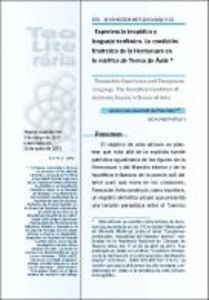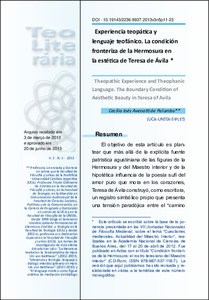Por favor, use este identificador para citar o enlazar este ítem:
https://repositorio.uca.edu.ar/handle/123456789/5180| Título: | Experiencia teopática y lenguaje teofánico : la condición fronteriza de la Hermosura en la estética de Teresa de Ávila | Autor: | Avenatti de Palumbo, Cecilia Inés | Palabras clave: | Teresa de Jesús, Santa, 1515-1582; LITERATURA ESPAÑOLA; ESTETICA; TEOFANIA | Fecha de publicación: | 2013 | Editorial: | Pontifícia Universidde Católica de São Paulo Associação Latino Americana de Literatura e Teologia (ALALITE) |
Cita: | Avenatti de Palumbo, Cecilia I. “Experiencia teopática y lenguaje teofánico : la condición fronteriza de la Hermosura en la estética de Teresa de Ávila” [en línea]. TeoLiterária, 3-5 (2013). doi:10.19143/2236-9937.2016v3n5p11-23 Disponible en: https://repositorio.uca.edu.ar/handle/123456789/5180 | Resumen: | Resumen: El objetivo de esta artículo es plantear que más allá de la explícita fuente patrística agustiniana de las figuras de la Hermosura y del Maestro interior y de la hipotética influencia de la poesía sufí del amor puro que mora en los corazones, Teresa de Ávila construyó, como escritora, un registro simbólico propio que presenta una tensión paradójica entre el “camino apofático” de desapego y silencio de todo lo que no es Dios y la afirmación del alma como un castillo concéntrico y cristalino en cuya interioridad habita la “Hermosura teofánica”. Así considerada la propuesta teresiana resulta cercana a los lenguajes poético-místicos de la espera y el vacío de nuestro tiempo, en la medida en que por medio del lenguaje simbólico ofrece el trazado de una estética y mística de la desnudez, en la que el Maestro interior revela la prístina Hermosura de su luz pura como meta del camino del hombre hacia el encuentro con Dios. Abstract: The aim of this article is to suggest that beyond the explicit source Augustinian Patristic figures of Beauty and the interior Master and the hypothetical influence of Sufi poetry of pure love that dwells in the hearts, Teresa of Avila constructed as writer, a record that has a symbolic own paradoxical tension between the “apophatic way” of indifference and silence of all that is not God and the affirmation of the soul as a castle whose concentric crystalline inhabits interiority “Beauty theophanic”. So Teresian proposal is considered near-mystical poetic languages of waiting and emptiness of our time, to the extent that through the symbolic language provides tracing and mystical aesthetics of nudity, in which the Master inside reveal the pristine beauty of pure light as the goal of man’s way to the encounter with God. |
URI: | https://repositorio.uca.edu.ar/handle/123456789/5180 | ISSN: | 2236-993 | Disciplina: | LITERATURA | DOI: | 10.19143/2236-9937.2016v3n5p11-23 | Derechos: | Acceso Abierto | Fuente: | TeoLiterária Vol.3 Nº5, 2013 |
| Aparece en las colecciones: | Artículos |
Ficheros en este ítem:
| Fichero | Descripción | Tamaño | Formato | |
|---|---|---|---|---|
| experiencia-teopatica-lenguaje-teofanico.jpg | 7,62 kB | JPEG |  Visualizar/Abrir | |
| experiencia-teopatica-lenguaje-teofanico.pdf | 484,14 kB | Adobe PDF |  Visualizar/Abrir |
Visualizaciones de página(s)
430
comprobado en 30-abr-2024
Descarga(s)
203
comprobado en 30-abr-2024
Google ScholarTM
Ver en Google Scholar
Altmetric
Altmetric
Este ítem está sujeto a una Licencia Creative Commons

